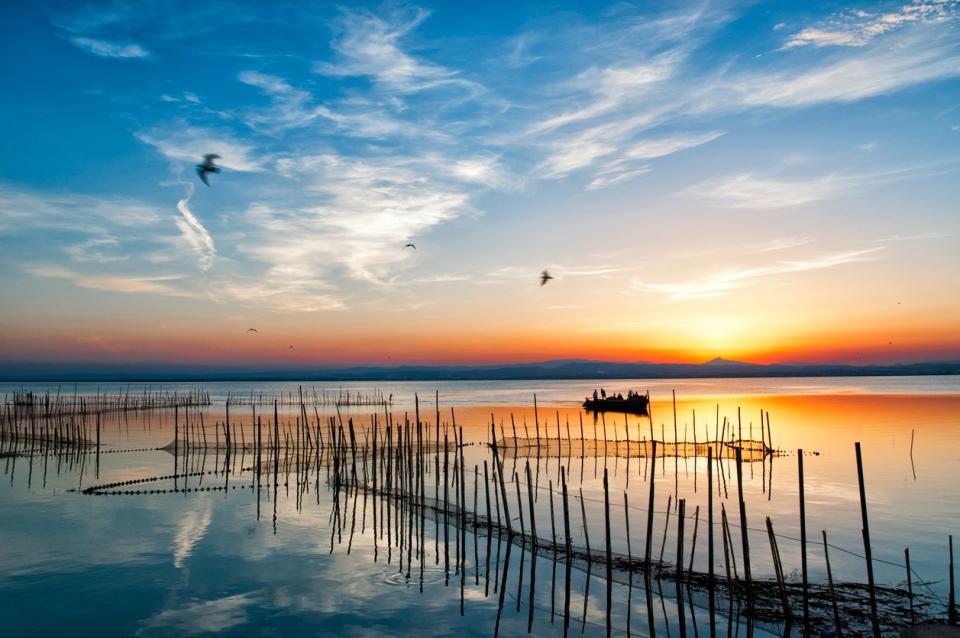How Valencia became the first city in the world to verify its tourism carbon emissions

Turia Gardens is perfect for cycling
(AFP/Getty)Cycling through the Turia Gardens, the park that curves for 9km around the centre of Valencia, is a handy and healthy way to get around Spain’s third-largest city, whether you need to get to work or want to see the sights.
A longstanding strategy to create a bike-friendly environment means the city has 150km of cycle lanes, as well as 40 streets with priority for cyclists. Valencia is aiming to become a “15-minute city”, with the key places where citizens and tourists are likely to want to go in a radius that is accessible on foot, by bike or by public transport within about a quarter of an hour.
The park follows the course of the Turia river, which was diverted away from the centre after a disastrous flood in 1957. A plan to build a ring road was abandoned after protests by the forward-thinking Valencians, who demanded instead that the riverbed should become a much-needed green space. The Turia Gardens opened in 1986 and the park is one of the largest in Spain, housing the spectacular City of Arts and Sciences, designed by Santiago Calatrava.

While there’s been a lot of talk about environmental issues in many cities of late, Valencia has been busy actually making things happen with a pioneering sustainable tourism strategy. It is the first city in the world to verify its carbon emissions from tourism-related activities, part of a commitment to be a carbon-neutral destination by 2025.
The Valencian water company Global Omnium, in collaboration with the Visit Valencia Foundation and the city council, measured the sources and environmental impact of greenhouse gas emissions in 2019 with respect to travel to Valencia, transport around the city, accommodation, restaurants, shopping, leisure activities, water management, waste treatment and tourism infrastructure. The study showed that 81 per cent of the carbon footprint in the tourism sector came from travel to the city, by plane, train and cruise ships.
Emiliano García, head of tourism at Valencia City Council, said: “This information means we can see what needs to be done. We have to increase our use of natural resources to generate renewable energy and expand the electric public transport network. We should also be using our green spaces to increase the absorption of CO2. We want to make Valencia one of the most sustainable cities in the world and attract the sort of tourists who share this outlook.”
Head out of the city centre to the north and you’re soon in a landscape of orange and olive groves, vineyards and fields of aubergines
Valencia’s geographical conditions give it a bit of an advantage when it comes to improving its environmental credentials. It’s pretty flat for a start, which is of course a big advantage when you want to encourage the use of both bikes and electric vehicles. The city always ranks well on quality of life polls, which is hardly surprising when you consider that it borders the Med, offering 20km of beaches, all with Blue Flag status, which are easily accessible by public transport or bike. Opt for the latter, and you can ride along the promenade and stop off for lunch on the terrace of one of the paella restaurants.
Perhaps the most extraordinary feature of Valencia is that it is surrounded to a large extent by agricultural land, known as L’Horta (garden), where fruit and vegetables have flourished since being introduced during the Islamic period, between the eighth and 13th centuries. Head out of the city centre to the north and you’re soon in a landscape of orange and olive groves, vineyards and fields of aubergines, onions and artichokes.
One of the most important crops is chufas – tiger nuts – which are actually a variety of tuber and grow underground. Tiger nut milk may have become fashionable in recent years, but in the Valencia region, horchata, made by crushing the tubers with ice and sugar, has been the signature summer drink for centuries.
Head south and you enter the Albufera, a natural park comprised of paddy fields and a huge lake, which is one of the most important wetland areas in Spain. It is here that the rice for all those paellas is grown, and there are some fabulous restaurants around the water and in the park’s villages, some in barracas: traditional fishermen’s houses with steeply-pitched thatched roofs.
In 2019, L’Horta was listed on the register of Globally Important Agricultural Heritage Systems (GIAHS), part of the UN Food and Agriculture Organisation (FAO). It is made up of thousands of small farms which use sustainable techniques and are irrigated by a network of channels that were dug out during the Islamic period to distribute water from the Turia river. This unique water management system, which has Unesco Intangible World Heritage status, has its own regulations that govern the supply across the area.

If you’re in Valencia on a Thursday, don’t miss the Tribunal de las Aguas (Water Court), which is held outside the cathedral at noon to sort out any disputes between the farmers and has remained unchanged for the last 1,000 years. The court, with eight black-clad judges sitting in a circle, is renowned for making swift decisions which are the final word on the matter in hand.
With the environmental measures Valencia has already instigated, it looks like this no-nonsense approach to managing natural resources has set a good example when it comes to creating a more sustainable future for the city.
Travel essentials
For more information about Valencia, visit the tourism board’s website here.
Read More
Greensill: ‘All decisions taken by the bank were made independently’, minister says
Prince Philip to have a ‘green’ funeral
Prince Philip to have a ‘green’ funeral
How Mallorca is setting a new sustainable standard in the Balearic Islands

 Yahoo Finance
Yahoo Finance 